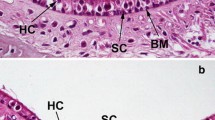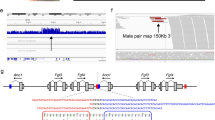Summary
-
1.
The fidget gene causes abnormalities in the gross structure of the vestibular part of the membranous labyrinth. The horizontal semicircular canal and its crista ampullaris are both missing. The superior and posterior canals remain rudimentary in form, but the sense organs associated with them are normal.
-
2.
The abnormalities of the membranous labyrinth lead to anomalies in the form of the osseous labyrinth and there is no subarcuate fossa.
-
3.
The parafloccular lobes of the cerebellum are displaced into an abnormal position under the other lateral lobes.
-
4.
The eyes and lens are reduced in size in fidgets, and the latter may remain in contact with the overlying ectoderm, which is probably a contributory cause of corneal ulcers.
-
5.
The lachrymal glands are missing and there are marked corneal ulcers in adult mice.
-
6.
In some fidget animals there is no mandibular canal.
-
7.
The fidget gene increases the number of fusions between certain bones of the skull and in the tarsals.
-
8.
In some fidgets there is a dislocation of the hip and in most fidgets the acetabulum is shallower than normal.
-
9.
The fidget gene increases the incidence of polydactylism.
-
10.
It is believed that the abnormalities of the membranous labyrinth are responsible for those of the osseous labyrinth and. still more indirectly, for the displacement of the paraflocculus. Similarly, the reduction of the lens is probably responsible for the reduction of the size of the eyes as a whole; and it is believed that the absence of the lachrymal glands (and with it the development of the corneal ulcers) is somehow connected with the rest of the eye anomalies. It is supposed that ear and eye anomalies may have a common cause the nature of which is, however, completely obscure. The physiological links of the statistical effects of the fidget gene with the more constant features of the syndrome remain to be discovered.
Similar content being viewed by others
References
Bean, A. M. (1929). A morphological analysis of the foot abnormalities occurring in the descendants of X-rayed mice.Amer. J. Anal. 43, 221–46.
Bonnevie, K. (1936). Abortive differentiation of the ear vesicles following a hereditary bram-anomaiy in the ‘short-tailed waltzing mice’.Genetica,18, 105–25.
Carter, T. C. (1951). The position of fidget in linkage group V of the house mouse.J. Genet. 50, 264–7.
Carter, T. C. (1951). The genetics of luxate mice. I. Morphological abnormalities of heterozygotes and homozygotes.J. Genet. 50, 277–99.
Carter, T. C. &Grüneberg, H. (1950). Linkage between fidget and agouti in the house mouse.Heredity,4, 373–6.
Chase, H. B. (1945). Studies on an anophthalmia strain of mice. V. Associated cranial nerves and brain centres.J. Comp. Neurol. 83, 121–39.
Chase, H. B. (1951). Inheritance of Polydactyly in the mouse.Genetics,36, 697–710.
Deol, M. S. (1954). The anomalies of the labyrinth of the mutants Varitint-waddler, shaker-2 and jerker in the mouse.J. Genet. 52, 562–88.
Deol, M, S. (1955a). Genetical studies on the skeleton of the mouse. XIV. Minor variations of the skull.J. Genet. 53, 498–514.
Deol, M. S. (19556). The anatomy and development of three mutants affecting the labyrinth in the mouse. (In preparation.)
Dunn, L. C. &Charles, D. R. (1937). Studies on spotting patterns. I. Analysis of quantitative variations in the pied spotting of the house mouse.Genetics,22, 14–42.
Fisher, R. (1953). The linkage of Polydactyly with leaden in the house mouse.Heredity,7, 91–5.
Glasstone, S. (1938). A comparative study of the developmentin vivo andin vitro of rat and rabbit molars.Proc. Roy. Soc. B,126, 315–30.
Gray, A. A. (1902). On a method of preparing the membranous labyrinth.J. Anal., Lond.,37, 379–81.
Green, M. C. (1953). A new inherited leg and foot abnormality, luxoid, in the house mouse.Genetics,38, 666 (Abstr.).
Grüneberg, H. (1943). Two new mutant genes in the house mouse.J. Genet. 45, 22–8.
Grüneberg, H. (1948). Some observations on the microphthalmia gene in the mouse.J. Genet. 49, 1–13.
Grüneberg, H. (1955). Genetical studies on the skeleton of the mouse. XV. Relations between major and minor variants.J. Genet. 53, 515–33.
Grüneberg, H., Hallpike, C. S. &,Ledoux, A. (1940). Observations on the structure, development and electrical reactions of the internal ear of the shaker-1 mouse (Mus musculus).Proc. Roy. Soc. B,12, 154–73.
Hertwig, P. (1944). Die Genese der Him- und Gehörorganmissbildungen bei röntgenmutierten Kreisler-Mäusen.Z. ges. Anat. 2.Z. KonstLehre,28, 327–54.
Hertwig, P. (1951). Entwicklungsgeschichtliche Untersuchungen über Bewegungsstömngen bei Mänsen.Verh. anal. Ges. Jena,49, 97–107.
Holt, S. B. (1945). A polydactyl gene in mice capable of nearly regular manifestation.Ann. Eugen., Lond.,12, 220–49.
Lennep, E. C. C. (1910). Het verloop der afwijkingen in bet gehoororgaan van de Japansche dansmuis, p. 82. Med. Dissertation, Utrecht.
Miller, G. (1950). Eine entwicklungsgeschichtliche Untersuchung über das erbliche Kolobom mit Mikrophthalmus bei der Hausmaus.Z. mikr. anat. Forsch. 56, 520–58.
Müller, G. (1951-2). Die embryonaie Entwieklung ernes sich rezessiv vererbenden Merkmals (Kolobom bei der Hausmaus).Wiss. Z. Martin-Lidher-Universität, Halle-Wittenberg,1, 27–43.
Searle, A. G. (1954). Genetical studies on the skeleton of the mouse. XI. The influence of diet on variation within pure lines.J. Genet. 52, 413–24.
Spemann, H. (1938).Embryanic development and induction. Pp. xii + 401. New Haven: Yale University Press.
Truslove, G. M. (1952). Genetical studies on the skeleton of the mouse. V. ‘Interfrontal’ and ‘parted fronfcals’.J. Genet. 51, 115–22.
Wallace, M. E. (1950). Locus of the gene ‘fidget’ in the house mouse.Nature., Land.,166, 407.
Author information
Authors and Affiliations
Rights and permissions
About this article
Cite this article
Truslove, G.M. The anatomy and development of the fidget mouse. J Genet 54, 64–86 (1956). https://doi.org/10.1007/BF02981704
Received:
Issue Date:
DOI: https://doi.org/10.1007/BF02981704




